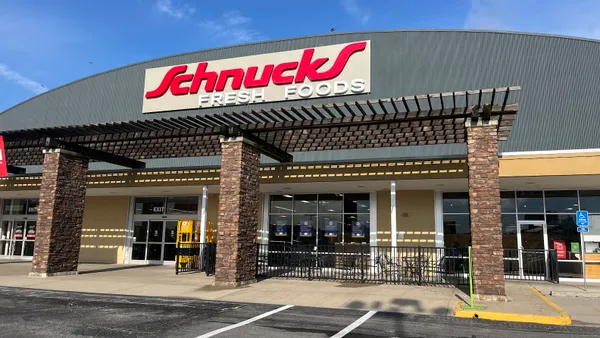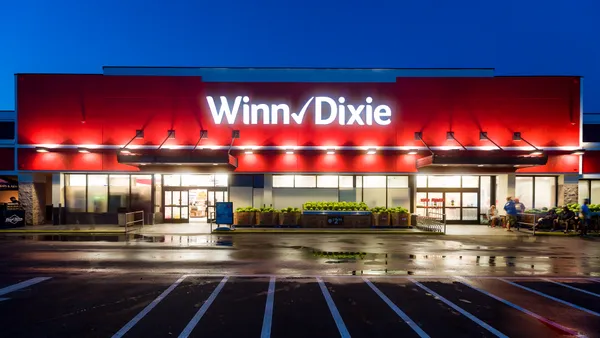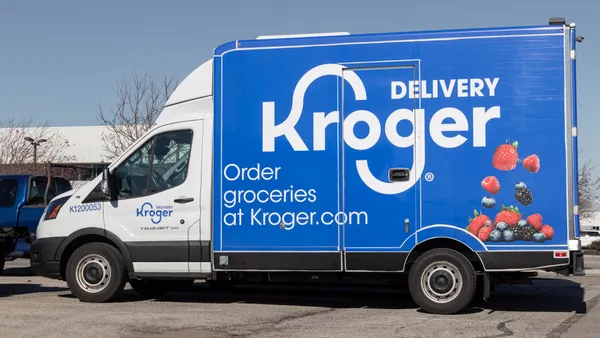Dive Brief:
- Kroger maintained its financial guidance for 2020 on Thursday amid mounting concerns over the coronavirus outbreak in the U.S. Chief executive Rodney McMullen said it’s too early to tell what sort of impact the outbreak, which has driven panic buying by consumers and supply chain disruptions, will have on the business. The company expects identical sales growth of 2.25% or higher over the fiscal year and earnings per share of $2.30 to $2.40.
- In the fourth quarter of 2019 ended Feb. 4, Kroger beat Wall Street expectations with identical sales growth of 2% and $327 million in profit, up from $259 million during the year-ago period. Executives said results were driven by strong returns in fresh categories and private label sales as well as a 22% increase in digital sales.
- During its earnings call Thursday morning, McMullen reiterated the flexible approach Kroger plans to take in building automated e-commerce fulfillment centers with e-grocer Ocado. “You should not just assume large facilities,” he said, noting the companies are exploring small and medium warehouses and store-based solutions in addition to the large, automated customer-fulfillment centers announced so far.
Dive Insight:
Kroger executives acknowledged that stores have experienced higher sales in categories like household essentials and personal care as a result of consumer anxiety related to the coronavirus outbreak. They also noted that Kroger has limited supply chain exposure to China, which has seen the vast majority of outbreaks and deaths linked to the virus, with most of the grocer’s products sourced domestically.
Fears over COVID-19, the illness caused by the coronavirus, have boosted sales for retailers across the country but also led to in-store and online stock-outs that have frustrated shoppers. Grocers are seeing a significant slice of their business moving to their e-commerce platforms, and are scrambling to keep up with demand while also clearly communicating with shoppers.
Kroger has created an internal task force that’s closely monitoring the virus’s progress and advising the company’s response, McMullen said, while maintaining it’s difficult to predict any long-term impact at this point.
“It’s really too early for us to have a sense of how customers’ overall behavior will change and what the impact will be,” Gary Millerchip, Kroger’s chief financial officer, told analysts. “I think you’ve seen more in response to the media activity and some of the advice out there in the market of customers starting to spend more on things like water and hand sanitizer, hand soap, paper.”
Kroger’s strong Q4 returns round out a year that started out weak but has seen comp sales and profitability improve. As the nation’s largest grocer faces mounting competitive pressure, it has tightened its focus on core grocery strengths and alternative investments. Private label brands like Simple Truth and Private Selection contributed $23.1 billion in sales across 2019, with 758 new product introductions along with the introduction of a new plant-based line. A renewed focus on pricing and merchandising in produce also lifted sales during Q4 and promise to be a strength moving forward, executives said, while its pharmacy business is seeing improved gross margins.
Kroger’s CPG marketing business and personal finance services drove the grocer’s alternative profit channel, with more than $100 million in revenue for 2019 and as much as $150 million forecast for fiscal 2020. The company has launched numerous initiatives since the launch of its Restock program, but the exit from its Lucky’s Market investment late last year indicates Kroger is closely evaluating its spending here. That divestment saddled Kroger with a $174 million charge in Q4.
Improving results combined with a recent $550 million investment from Berkshire Hathaway indicate Kroger could turn a corner in 2020. But with the twin pressures of slimming margins and the need for an effective, differentiated e-commerce game plan, the company is still walking a tightrope.
Amazon and Walmart are both rapidly scaling their online grocery platforms and netting new customers as they do so. Walmart is reportedly working on an enhanced loyalty program that includes a revamp of its grocery delivery subscription service. Last fall, Amazon brought its Fresh service under Prime and did away with the $15 delivery fee, and the company says that decision along with an accelerating rollout across Fresh and Whole Foods stores is boosting sales.
Kroger still offers delivery through third-party providers Instacart and Shipt and charges a $5-per-order fee for its ClickList pickup service. The grocer tested waiving the ClickList fee during the 2019 holidays — a move that boosted adoption, McMullen noted, without saying whether the company would perform further tests or do away with the fee entirely at some point.
Kroger’s plan to build large, pricey automated fulfillment centers, meanwhile, is starting to look stale against the rapid rollout of micro-fulfillment solutions from the likes of Albertsons, Ahold Delhaize, Walmart and, reportedly, Amazon. Kroger executives noted during the company’s investors day last November it will roll out smaller facilities, as well, but didn’t provide much in the way of specifics, including cost projections.
On Thursday, McMullen characterized its fulfillment strategy as fluid and developing in step with Ocado. The two companies are designing a “flexible distribution network,” he said, that should include small and medium-sized facilities as well as the large customer fulfillment centers (CFCs) with Ocado. So far, Kroger has announced construction locations for six of its expected 20 CFCs, with the most recent coming in Frederick, Maryland. Within a year’s time, the first CFC will be live in Monroe, Ohio.
“Ocado continues to spend significant money in research and development,” McMullen said. “We expect it’ll be a combination of store-based facilities, smaller type facilities and bigger type regional facilities, and Ocado will be a critical partner in that ecosystem.”









